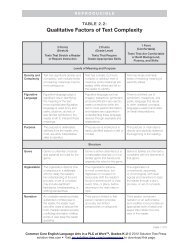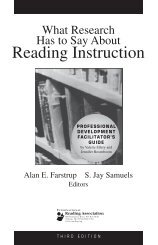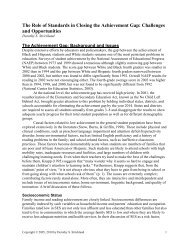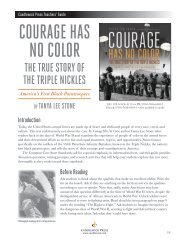A Practical Guide to Action Research for Literacy Educators
A Practical Guide to Action Research for Literacy Educators
A Practical Guide to Action Research for Literacy Educators
You also want an ePaper? Increase the reach of your titles
YUMPU automatically turns print PDFs into web optimized ePapers that Google loves.
Table of Contents<br />
INTRODUCTION.................................................................................................................................................................1<br />
A BRIEF HISTORY OF ACTION RESEARCH ....................................................................................................................4<br />
What is <strong>Action</strong> <strong>Research</strong>?..............................................................................................................................................4<br />
Principles of <strong>Action</strong> <strong>Research</strong>.......................................................................................................................................6<br />
WHY SHOULD I DO ACTION RESEARCH IN MY CLASSROOM? ................................................................................9<br />
WHO USES ACTION RESEARCH? ...................................................................................................................................12<br />
THE ROLE OF ADMINISTRATORS IN ACTION RESEARCH.......................................................................................15<br />
A Culture of <strong>Research</strong>.................................................................................................................................................16<br />
THE ACTION RESEARCH PROCESS...............................................................................................................................18<br />
The <strong>Action</strong> <strong>Research</strong> Cycle .........................................................................................................................................19<br />
IDENTIFY A PROBLEM AND ASK A QUESTION..........................................................................................................21<br />
How <strong>to</strong> Form a <strong>Research</strong> Question ............................................................................................................................26<br />
Example: How <strong>to</strong> Form a <strong>Research</strong> Question ............................................................................................................27<br />
CREATE AN ACTION PLAN..............................................................................................................................................28<br />
Seek Knowledge ..........................................................................................................................................................28<br />
Organizing Your In<strong>for</strong>mation ....................................................................................................................................29<br />
Summarizing Your In<strong>for</strong>mation.................................................................................................................................30<br />
Developing the <strong>Action</strong> Plan........................................................................................................................................30<br />
Checklist <strong>for</strong> the <strong>Action</strong> Plan......................................................................................................................................33<br />
ENACT THE PLAN AND COLLECT DATA.......................................................................................................................34<br />
Quantitative and Qualitative Data .............................................................................................................................35<br />
Data Sources ...............................................................................................................................................................35<br />
Reliability and Validity of Data ..................................................................................................................................36<br />
The Triangulation Method .........................................................................................................................................37<br />
Example: Triangulating Data <strong>for</strong> <strong>Action</strong> <strong>Research</strong> on Literature Circles ..................................................................39<br />
Interview Techniques..................................................................................................................................................40<br />
Observation Techniques .............................................................................................................................................42<br />
Checklist <strong>for</strong> a Discussion Group...............................................................................................................................43<br />
vi
















